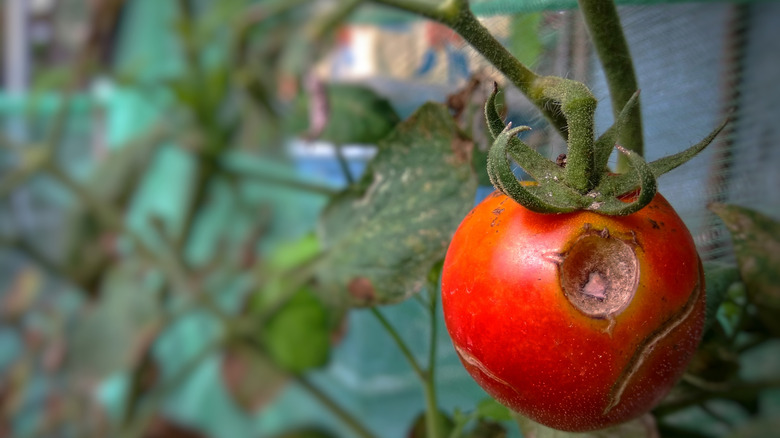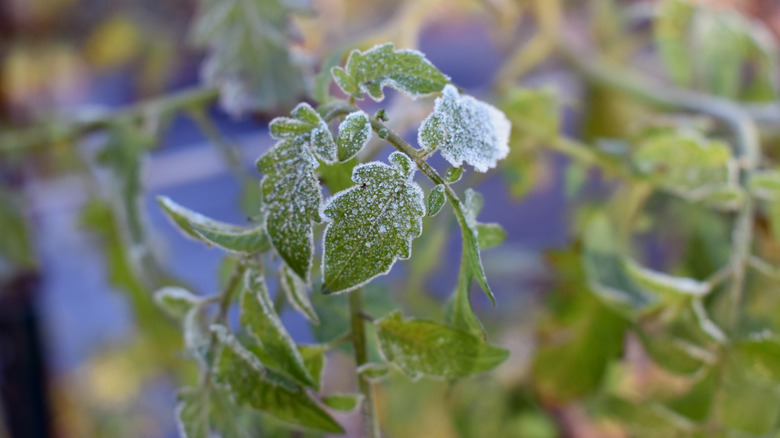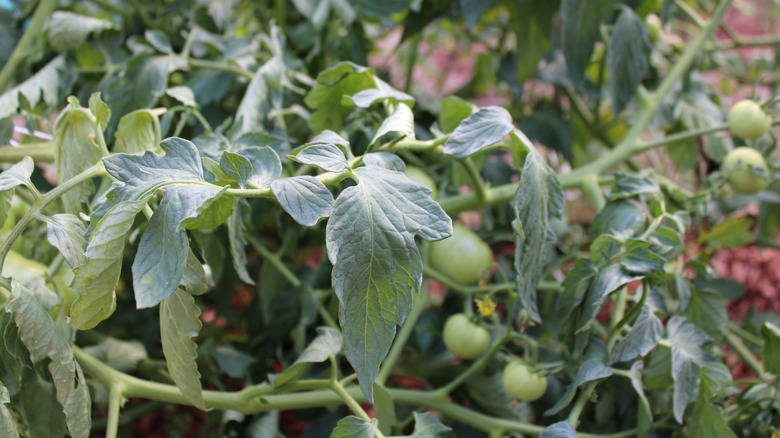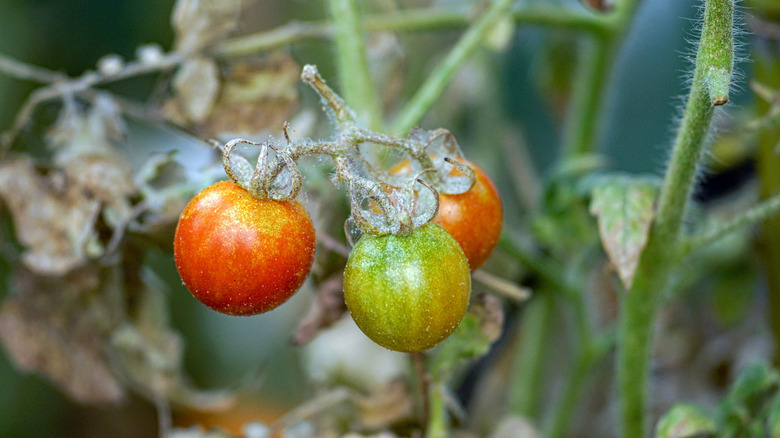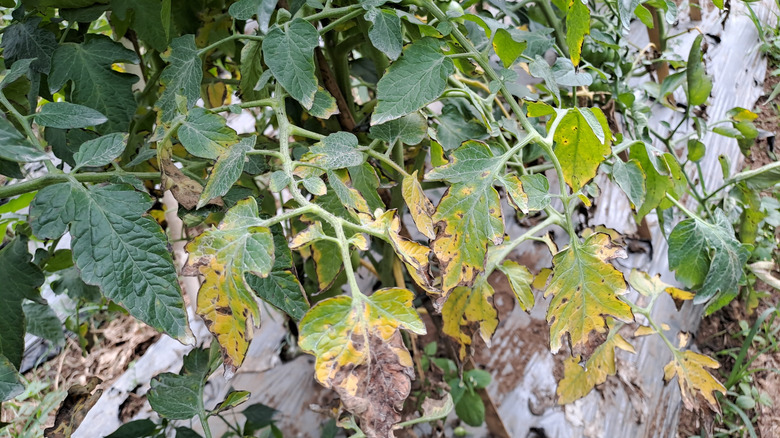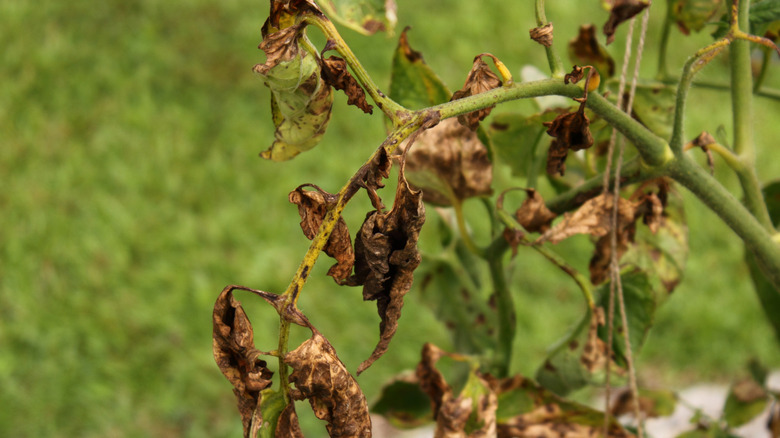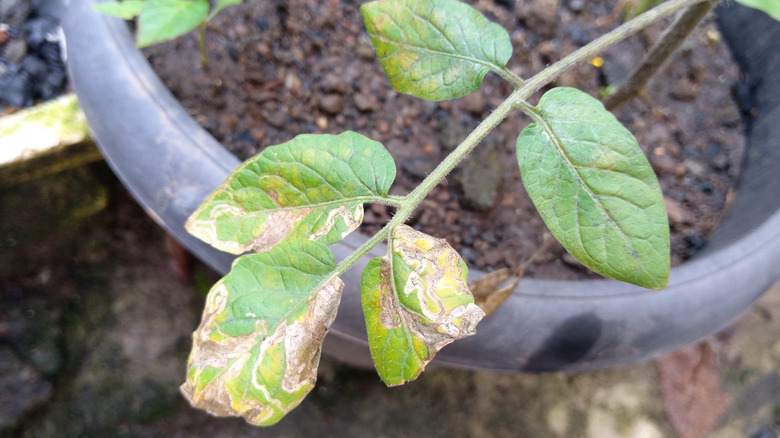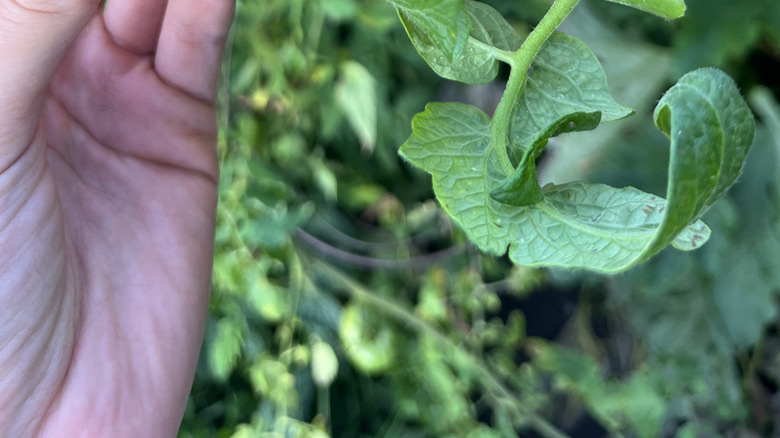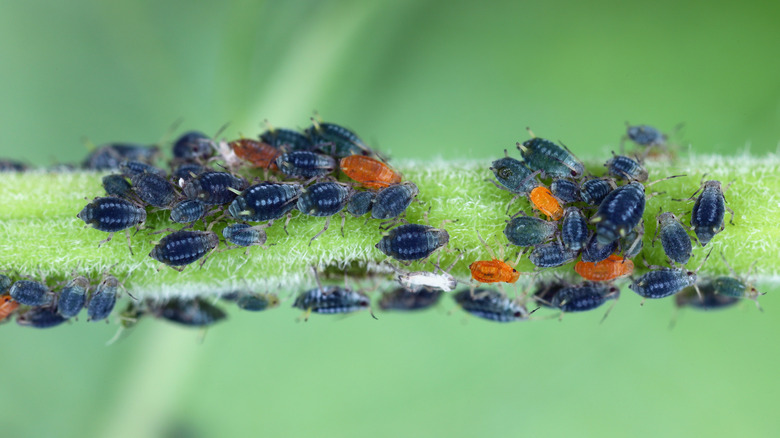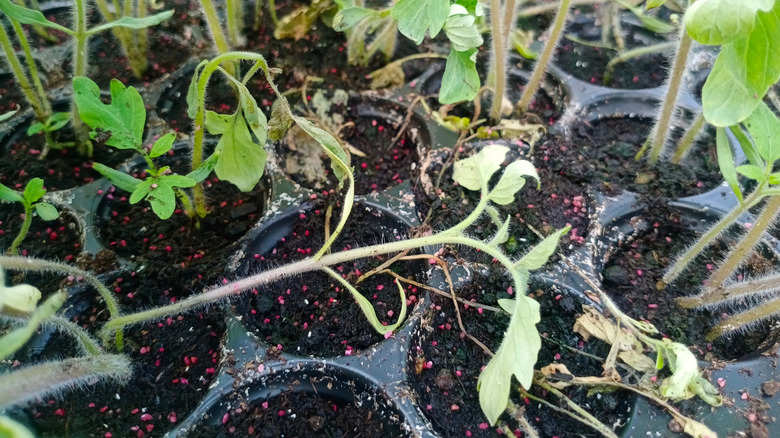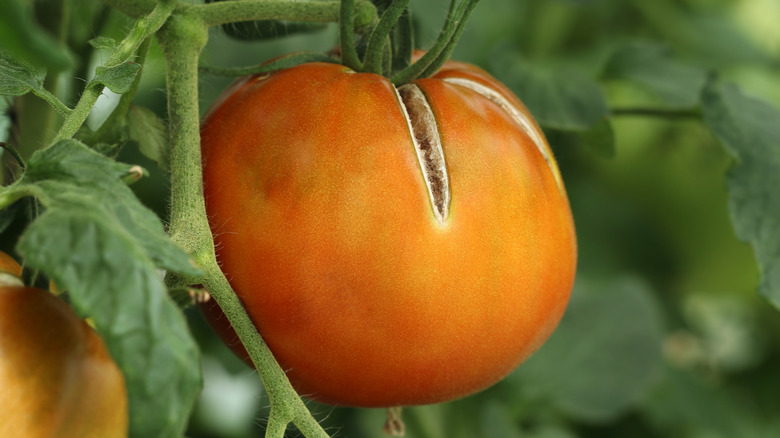10 Common Diseases And Problems With Garden Tomatoes And Tips For Prevention
We may receive a commission on purchases made from links.
If you're growing tomatoes in your garden, it's a pretty safe bet that you want them to become plump, red, and juicy. You don't want to deal with diseases, pests, and other issues that can compromise the fruity quality, decrease the overall yield, or even kill the plants altogether. You may have heard that tomatoes are easy to grow. And, while this is true to a certain extent, if you want to grow the best tomatoes in your home garden, you need to be prepared to give them the care and attention they need in order to thrive.
There are, unfortunately, a range of problems that can plague your tomato plants. So, before you put your plants or seeds in the ground, you'll want to learn more about the challenges you might face. If you already have tomato plants in your garden, it is equally important to educate yourself so you can minimize any harm that has already been done and take steps to prevent any future issues. Ahead, we'll outline some of the most common problems that you might face as a home tomato gardener. We'll also share some tips to help you remedy these issues if they pop up to keep them from becoming a large-scale problem, along with some suggestions to completely avoid them altogether.
Cold temperatures and frost can threaten tomatoes
While some plants are hardy enough to survive cold weather, tomatoes are not one of them. If the outdoor temperatures get too low, it can cause damage to the tomatoes themselves, as well as the rest of the plant. Frost and freezing temperatures may even kill the plants altogether, wiping out your yield for the season in a single day. Planting at the wrong time is a common mistake people make with tomatoes that can increase the likelihood of frost damage. When outdoor temperatures drop to 32 degrees Fahrenheit or lower, frost can form on the plants.
To minimize the odds of damage, it is important to wait to transplant your tomatoes until the risk for frost has passed for your growing zone. Where you live will determine how early or late this date is. For example, those in USDA Zones 3 and 4 should wait to move their plants outside until at least May 15th, while those who live in Zone 8 should be safe to transplant as early as March 15th.
Sometimes the weather can be unpredictable, or you might have moved your plants out earlier without realizing the error in your ways. In these cases, be sure to cover the plants in your garden with something like the Valibe Blanket Plant Cover, or bring any tomatoes in a container in for the night. Doing so can minimize the risk of damage. After the weather has warmed up, take off the covers and inspect any plants that were left outside. If there are any signs of damage, you'll want to pick any tomatoes that are ripe and either use them or freeze them for later use.
Excessively hot temperatures are also not good for tomato plants
Cold weather isn't the only thing that can threaten tomato plants. While the plants do grow best in warm weather, too much heat can threaten their health. A moderate 70 to 75 degrees Fahrenheit is considered ideal for tomatoes. When the thermometer reads closer to 90 degrees Fahrenheit — or even hotter — it can spell real trouble for your plant. Temperatures this high can cause heat stress. The specific effects of heat stress will depend on where the plants are in the process of producing tomatoes. For example, the blossoms can drop, preventing any tomatoes from growing, if these high temperatures occur between one and two weeks before flowering. If the fruit has already started growing when temperatures start ramping up, they won't be saved, either. A variety of problems, including sunscald and tomato pox are possible. So, when you're worried about why your tomatoes aren't ripening properly or growing at all, don't overlook the possibility that the summer heat is to blame.
There are some things you can do to help protect your plants against heat stress. Just as you are cooler in the shade on a hot day, the same will be true for your tomatoes. Therefore, providing some shade for the plants, particularly against the hotter afternoon sun, can be very beneficial. Just remember, they'll still need some sunlight, ideally during the earlier morning hours, in order to grow properly. A 50% shade cloth, such as the Kesfitt Garden 50% Shade Cloth, can reduce the amount of heat and sunlight reaching the tomatoes to minimize the effects of heat stress. When the temperature outside is really high, you'll also want to make sure you're giving the plants some extra water to make up for what is evaporating in the heat. Similarly, mulching around the base of the plants can also be helpful, as it will help the soil retain more moisture.
Knowing how to spot spider mites before they turn into a huge problem can be a real asset
It is not uncommon for spider mites to cause damage to the tomato plants in a garden. These tiny arachnids — often smaller than 1/32 of an inch — are most likely to be found on the undersides of the plant's leaves. Here, they'll not only feed, but will also mate, causing a small infestation to grow. Spider mites eat by sucking the sap out of the leaves, which can leave the plant covered with yellowish-white lines. Over time, the damage will become more noticeable, with the stippling becoming a darker bronze color and the leaves turning brown. When an infestation is bad enough, it can also result in damage to the tomatoes themselves, leaving them covered with small yellow splotches. Unfortunately, because of how tiny they are, the bugs are easy to miss. This means that a small problem can turn into a large infestation if you don't know what to look for.
To prevent this from happening, you'll want to make a habit of checking your tomato plants for evidence of the arachnids at least a few times each week. Be sure to flip the leaves over, since that's where they're most likely to be, and look for any stippling or off-looking fruits. There are some things that you can do to protect your plants against an infestation. First, because an infestation is most likely to occur when the plant is dry or dusty, be sure to keep up with a regular watering routine. You can also try planting an easy-to-grow garden vegetable to protect the tomatoes against the mites. Spider mites find garlic to be too pungent and may stay away if it is planted close to your tomatoes. You can also consider some vegetable-garden approved, natural insecticides, such as neem oil or horticultural oil.
Early blight can lead to yellowing leaves, fruits with sunken spots, and more
Early blight is one problem you don't want your tomatoes to face. Caused by a fungus, the disease has the potential to cause serious problems. These may include yellowing leaves, defoliation, and fruits with sunken or decaying sections, amongst others. One of the many problems with early blight is that the fungus that causes it can survive through the winter, infecting next year's crop as well.
While it can be difficult to protect your plants, there are still some things you can do to stop tomato blight in its tracks. One of the practices recommended by gardening experts is to utilize crop rotation. Instead of growing tomatoes in the same spot in the garden every year, set up a schedule to rotate them with other plants about every three or four years. Healthy plants also fare better against blight, so make sure that you're meeting the watering, lighting, and other needs of your plants. There are also some blight-resistant tomato varieties that you can consider growing. These include 'Beefmaster,' 'Gladiator,' 'Juliet,' and 'Early Girl.'
Wilting tomato plants will have a very sickly looking appearance
There are a few different types of wilt that may plague your tomato plants. And, while some of these may look similar at first glance, there are key differences that can help clue you into the specific problem you're facing to help you appropriately address it. Two common forms of wilt for tomato plants are fusarium wilt and verticillium wilt. Unlike bacterial wilt, both of these infections start at the base of the plant and work their way up. Plants infected with fusarium wilt have yellow or brown leaves that may start only on a single side of the plant. After the leaves have started to change color and the disease progresses, the stems and leaves of the plant will begin to wilt. Verticillium wilt offers similar yellowing of the plant's leaves. However, it can be distinguished from fusarium wild by the V-shaped markings that form along the leaves as well. Both of these diseases have the potential to kill an entire plant, or at a minimum significantly reduce the number of tomatoes it produces.
Unfortunately, there is nothing you can do to get rid of fusarium or verticillium wilt on your plants. The fungus responsible for the infection can also survive in the soil, potentially making it difficult to grow new plants there, even in future years. If your tomato plants develop wilt, you should clear them out of the garden immediately to prevent the fungus from spreading. One of the top recommendations offered by gardening experts is to opt for wilt-resistant tomato plants that will have a better chance of surviving, even if the fungus is present. However, keep in mind that just because a certain variety is resistant, it does not mean that it is completely immune from infection.
Tomato plants infected with Septoria leaf spot may lose all of their foliage
Like early blight, Septoria leaf spot is a fungal disease that can be detrimental to the health of a tomato plant. The fungus that causes the disease (Septoria lycopersici) is able to survive on dead plants, increasing the chances that it will infect others around them. If you're regularly inspecting your tomato plants, you might be able to catch Septoria leaf spot early. When first infected, plants will have small dots scattered over their stems and leaves. The little spots have a lighter center with a darker border. And, as the disease progresses, smaller spots will clump together, which can be devastating for the plant's leaves. Some can lose all of their leaves or even die because of this disease.
Septoria leaf spot is another disease that is very difficult to get rid of once it becomes a problem. As noted above, the fungus remains alive on dead plants, along with those that are still alive. So, if you notice any signs of Septoria leaf spot on your plants, one of the first things you'll want to do is to remove any infected stems or leaves. With these growths removed, more airflow should also be able to circulate, which can help prevent the fungus from spreading. Additionally, some fungicides can be used to mitigate the disease. Just be sure to choose one that is labeled as safe for use on vegetables, such as Bonide Captain Jack's Copper Fungicide, and follow the manufacturer's instructions for how to apply it to your plants.
Tomato hornworms enjoy munching on the leaves of a tomato plant — and can do serious damage
While hornworms don't exclusively eat tomatoes (they will also munch on other members of the nightshade family), there's a reason they were given the name they have. Tomatoes are the favorite food of these pests — and they can really do a number to a plant over a very short period of time. These large green caterpillars — which can be as long as 4 inches — will munch on your crops, potentially removing all the leaves or leaving holes scattered throughout the tomato fruits.
Fortunately, there are some good ways to get rid of tomato worms. One effective solution is to attract braconid wasps to your garden. The wasps lay their eggs directly on the hornworm, and when the larvae emerge they will eat the hornworm before forming their pupas over its back. For this reason, if you notice hornworms with several small white lines on their back, you'll want to leave them alone, as more wasps will emerge to continue decreasing the population. You can also attract other natural predators of hornworms, including lacewings and ladybugs. If you only have a few hornworms, you can physically pick them off of your plants to prevent it from turning into a full-blown infestation.
An aphid infestation can spread quickly, with the pests sucking the sap from the leaves of your tomato plants
Aphids are another common pest that will attack your tomatoes in the garden. Like spider mites, aphids are sap-suckers. They'll use their sharp mouthparts to remove the sap from the leaves of your tomato plants. This can be devastating for more than just the leaves themselves. It can cause the plant to weaken and become generally unhealthy. The presence of aphids often means that the plant will produce fewer tomatoes. With their small size, only about 1/8-inch long, aphids can also be difficult to see. Some are even green and may blend in more with the leaves. Other aphids can be pink or a combination of pink and green. One of the challenges of facing an aphid problem is how short their life cycle is. For some members of the species, they can go through the full life cycle — including reproduction — in fewer than 10 days.
There are a few different ways that you can try to clear up an aphid infestation. Inspecting your plants regularly for any signs of the pests will be important, since they are so small and easy to miss if you aren't looking closely. If you spot any aphids, pull out your garden hose and use it to hit the bugs with a stream of water. You can also cut off any portions of the plant that have been severely impacted by the pests.
Damping off is a problem that can plague your plants before they even get a chance to start growing
Most of the tomato disease and problems we've covered take place after the plant has started to grow. However, damping off is an exception to this rule. It occurs before the plant has a chance to really get established, either while it is still a seedling or before it has even germinated. Caused by a fungus, damping off can result in tomato plant stems becoming overly thin and wiry. As you may guess, this is not good for the rest of the plant. With such a weak stem, the small growths that have started will fall over, and the plant will die. Seedlings are most likely to be susceptible to damping off when too much moisture accumulates, such as when humidity levels are high or there is not sufficient space around the roots for air to circulate and dry everything out.
Fortunately, there are some things you can do to prevent damping off, or at least to greatly reduce the number of seeds and seedlings that are killed by it. One crucial step is to make sure you aren't creating conditions that are overly moist. While your new tomato plants will need water, take care to avoid leaving the soil excessively damp. You'll also want to make sure that you are planting the seeds far enough apart to allow proper air circulation. Sometimes, the seeds you buy may already be infected. This is why it is imperative to buy certified disease-free tomato seeds.
Growth cracks can occur when the tomatoes experience inconsistent levels of moisture
Have you ever picked one of the tomatoes from your garden only to be disappointed by what you see? Some tomatoes have cracks, which often originate from where the stem is connected to the fruit. These cracks, which are also called radial cracking, can be very frustrating to find when you've taken measures to give your tomato plants the care they need and to protect them against all of the diseases shared above. The cause of these cracks relates to moisture levels. They're most likely to occur following a drastic change in how moist the soil is — such as when a dry spell follows several days of heavier rains. The heavier rains cause the fruits to grow very quickly, and when followed by dryness, they can start to crack.
You obviously can't control the rainfall in your area. However, you can take measures to ensure the plants are receiving a more consistent supply of water. When there is no rain in the forecast for several days, pull out the garden hose to provide more water to the plants. Mulching around the base can also be effective, as it will help retain moisture. So, when that wetter period ends, the roots will still have access to enough water to hopefully prevent the tomatoes from cracking.
